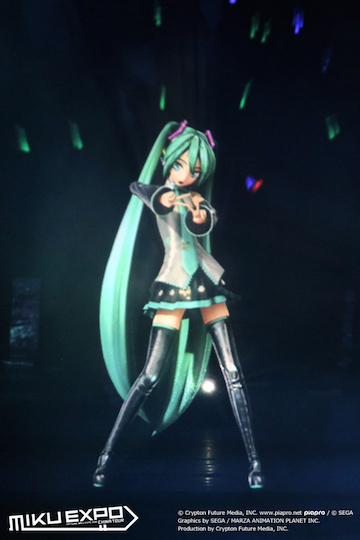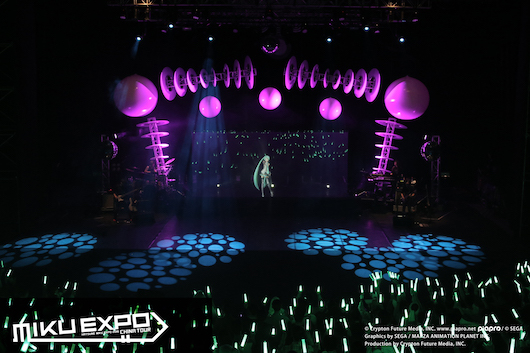Technology Tackles Human Powers
vol.2
How Hatsune Miku Was Born
Sasaki Wataru, Hokkaido
2017.07.07
©You Sung Gil
Known as the creator of the Vocaloid Hatsune Miku, Sasaki Wataru is a software developer at Crypton Future Media, Inc. Hatsune Miku is actually software developed to make a computer sing songs, and Sasaki tells us the ideas that were behind the software he created. For him, he says, the most important thing about Hatsune Miku is that she makes him aware of a whole spectrum of technologies.
Responding to the Culture in Japan

The "Hatsune Miku Expo" China Tour.
© Crypton Future Media, INC. www.piapro.net / © SEGA Graphics by SEGA / MARZA ANIMATION PLANET INC. Production by Crypton Future Media, INC.
Vocaloid* is a software through which a computer sings songs when you input lyrics and melody. At first we at Crypton worked with Yamaha, which had developed the software, on a product for English-speaking markets. Crypton had well-established connections with sound production companies overseas and we initially planned to get in touch with several companies and develop the product in English, and then in Japanese, Spanish, and other languages.
But we found that development for the English-speaking market did not go very well. There seemed to be resistance--perhaps deriving from religious beliefs--to the idea of "humans creating humanoids." So, when I was put in charge of developing a product for the Japanese market, I decided to make it something that would fit in with the culture in Japan.
First I explored what would be effective marketing methods, given the impression made by the word Vocaloid. Since synthesized sounds are often used in SF movies, I decided the theme should have an SF or futuristic character. I also wanted to draw from the images of female androids that have been created by Japan's SF culture as well as graphic styles from anime and manga.
*Vocaloid: singing-voice synthesizer technology developed by Yamaha Corporation and software applying that technology. Vocaloid and Vocalo are trademarks of Yamaha Corporation.
Hatsune Miku's Basic Traits
©You Sung Gil
First, I insisted that the voice be clear and bright--because, after all, a high-pitched, bright voice is well suited to a futuristic image. Looking back over the history of Japanese popular music, the popular singer "idols" of a few decades ago--like Yamaguchi Momoe and Nakamori Akina--tended to sing in low registers. The voices of more recent popular singers--Onyanko Club, Morning Musume, AKB48, and the voice actresses--have become quite a bit higher in register and lighter in quality. We can see that trend not just in Japan, in fact, but worldwide. I think the voices will become even higher-pitched in the future.
And I wanted the voice to be lively. The recorded female voices you hear in taxis or trains in Japan are mechanical or synthetic sounds and have an artificial, lifeless quality. As a child, I recall hearing television narrators who spoke in an overbearing, non-human-sounding tone--that seemed kind of scary to me. The announcements over the school PA system I heard in junior high school were somewhat artificial, but the voices actually sounded rather sweet. What I wanted to aim for was that latter quality.
To create Vocaloid, we record a human voice and then create a library of sound fragments for Japanese phonemes. The software makes the Vocaloid sing by combining those sounds. In the process of mechanical manipulation of the sounds in order to smooth the transitions between the sounds, some qualities of the original voice are lost. The intonation, too, is slightly flatter than that of a human singer. What you get, therefore, is a voice with slightly different traits than the original voice. We came to understand our Vocaloid as a "virtual singer" with a distinctive voice different from what a human being would have.
The Search for Hatsune Miku's Voice
©You Sung Gil
So, I first began to search for the voice that would be the base for the Vocaloid. I listened to CDs of the voice actresses affiliated with the three major voice acting production studios and also collected CDs for newcomer voice actresses. Out of all those I chose the young voice actress Fujita Saki. Her voice is quite high, but also strong and good on the sustained notes. I liked it also that it was her natural voice, reasoning that it would be more stable in the course of repeated recordings than a "performed voice."
For the creation of Hatsune Miku's physical character, I decided her age and figure beforehand and asked an illustrator to create her. When the voice was selected, I had decided to make the Yamaha DX7 synthesizer the motif. DX7 was well known for its metallic sounds and capability in producing quite high electronic sounds. I took a chance on this decision because Hatsune Miku had a high-pitched voice and had been developed with Yamaha technology from the outset.
The striking blue-green image color was matched to the DX7. Hatsune Miku would have taken on a completely different appearance if I had not had the DX7 as a motif.
Timely Impetus of Demand and Technology
©You Sung Gil
The response, after Hatsune Miku was released in 2007, was rapid and more successful than expected. I think one reason is that it happened to dovetail neatly with lifestyle changes taking place in Japan at the time. In the United States, I understand that people have various places to sing out loud, such as at church on Sundays, and they can gather friends for home parties on weekends. But most people in Japan live in small houses, condominiums, or apartments, and there are few places where they can sing openly or get together to play instruments and the like. Around then, people had begun to notice a tendency among young men to avoid going out drinking with their workmates (as had been the norm in the past), but to minimize communication with older or younger co-workers. In that environment, the desire among such men--dubbed soshoku danshi ("grass-eating," as opposed to "carnivore" men)--to spend their time alone, writing music and using Vocaloid to sing their songs, was gradually building.
Another important factor propelling the success of Hatsune Miku was the expansion of communications infrastructure capable of distributing high-volume data via the Internet. It was just about the time that people began to communicate mainly via the Internet and posting of original video works online via YouTube and the like had begun to spread. As a result, the activity of writing songs and using Hatsune Miku to sing them for posting online gained even further momentum.
It wasn't long until we began to receive offers from the big Tokyo-based companies to make CDs of Hatsune Miku songs or register her as an "idol" star with their studio. Japan's music world is centered almost completely on Tokyo.
But we refused these offers. Our company is based in Sapporo, you see, and it's made up of people who are above all attached to the Internet. Our idea was that it would be better to let Hatsune Miku spread via the Internet as far as it could go, and then think about CDs, singers on contract, and so forth. In a way, it was easier to refuse the offers, arguing that "Well, we're based in Hokkaido."
Enjoyment for Everyone
©You Sung Gil
It may not be quite an "urban legend," but the Hatsune Miku Vocaloid went on to spread rapidly through the Internet, and for a while everyone was asking "who's Hatsune Miku?" Some anime fans were mystified, wondering what anime she had appeared in. Some music fans were critical of the voice, saying it was mechanical and hard on the ears. There was the "anti-Hatsune Miku" camp, but the pros-and-cons debate helped stir up discussion and word spread. Some figure fans enjoyed the dynamic compositions that could be created with her long hair, and many people learned about her via games, cosplay, and karaoke.
We at Crypton were not necessarily keeping up with everything that was going on and no one really knew the whole picture. But the situation in which there was actually no one person who was the "authority" on Hatsune Miku turned out to be a good thing, at least for users; it was better that there was no one claiming to have all the right answers. Ways of encountering and enjoying Hatsune Miku were as numerous as there were users, and so everyone was doing just that.
Appeal of the Vocaloid Voice
In 2009, in order to respond to the wishes of fans, a series of live concerts, serving as offline meeting events, began. In 2013, a concert was held in Yokohama at which the performance by Hatsune Miku was a light show projected on a screen formed by jets of water sprayed into the air.
We've done many experiments--projecting Hatsune Miku onto the clouds, onto window screens, and so forth, crossing her with all sorts of new technologies. I think having Hatsune Miku introduce the delights of digital technology--she herself being ditigal--would be much more likely to gain acceptance than if attempted by humans.

The "Hatsune Miku Expo" China Tour.
© Crypton Future Media, INC. www.piapro.net / © SEGA Graphics by SEGA / MARZA ANIMATION PLANET INC. Production by Crypton Future Media, INC.
A Vocaloid voice does have a clumsiness, but also an appeal distinct from a human voice. A Vocaloid can sustain high notes as long as desired and can sing even the most complicated of melodies. Fatigue and emotional states invariably affect the performance of human singers, but with the Vocaloid there are no such worries. We are now trying to enhance Hatsune Miku's artistry as a singer as much as possible, making the best of the positive assets of human singers, and eliminating the bad ones. I think we can also use the Vocaloid software for speaking voices, and would like to try dramatic performances such as kabuki for the stage; Vocaloid performers could take on various roles.
I also want to create more distinctive voices, creating a different series of characters. We are also working on the technology of Vocaloids in various languages. The first in the series to be released will be a Chinese edition.
Awareness of the Immense System We Live in
©You Sung Gil
For me, Hatsune Miku is big because it makes us aware of technology. From the time I was born, Japan has been at peace and the country's infrastructure has been well in place. I have always felt I was living in some kind of immense system and being carried along the rails of life automatically.
But I think that, if we don't live with some awareness of that system and the technology that makes it function, we will end up not knowing where we are. I have always liked thinking about technology, about the nature of society, what makes sounds and voices, and all sorts of things--that was my hobby. The creation of Hatsune Miku has been a gift because she has allowed me to incorporate those interests into my work. I'm very grateful for that.
I might mention, by the way, that right after I created Hatsune Miku, my mother called me up and told me that she had found paper from my kindergarten days headed "What do you want to be in the future?" I had written the word "robot." Probably I was attracted to what we were seeing in the superhero animated films--robots in the shape of a humans that could do things humans couldn't. So already back then I was dreaming about humanoid robots! It's quite amazing to think that we are about halfway to realizing something that was just a figment of the imagination when I was in kindergarten.
【Interview:February 2017】
Compilation:Yamagishi Hayase



